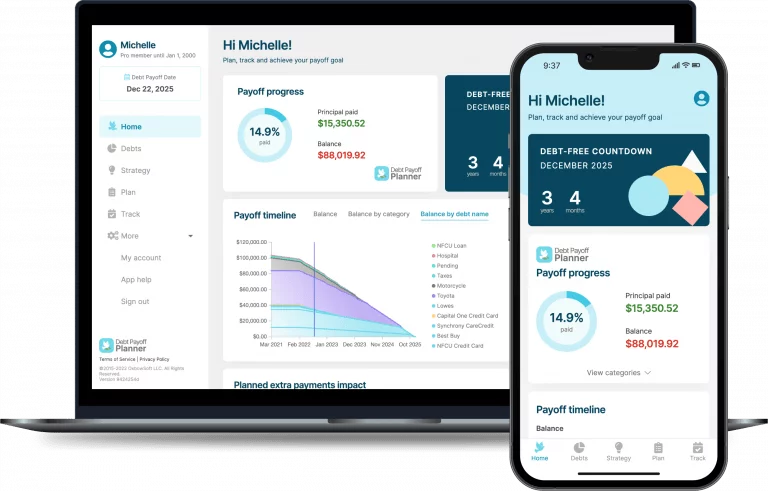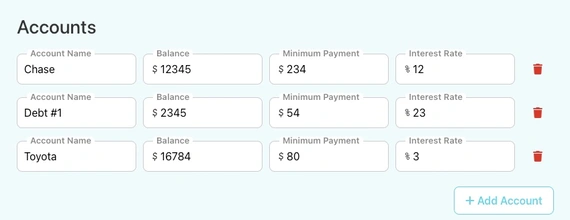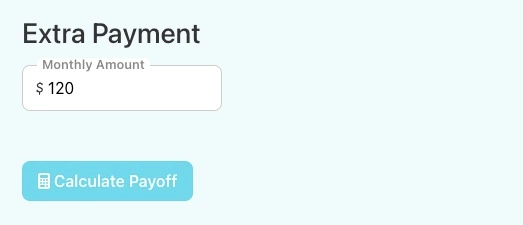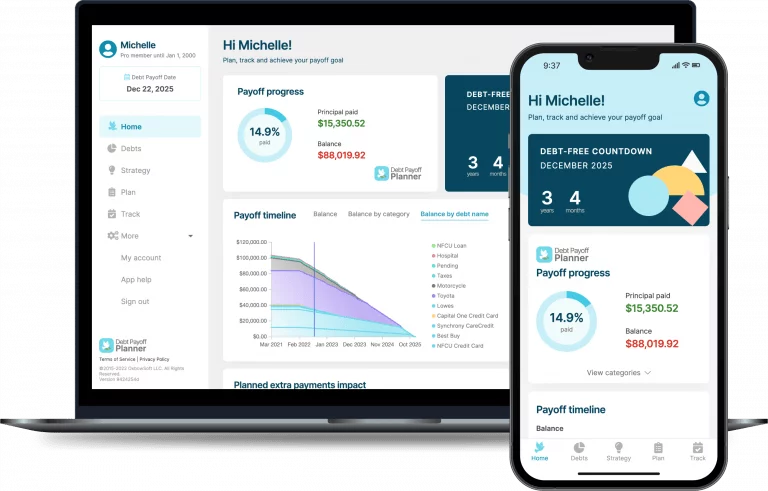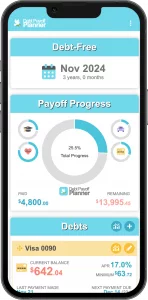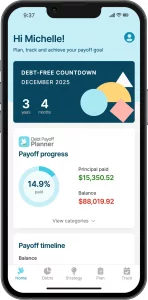Debt Snowball Calculator
Quickly see when you can become debt-free if you follow the debt snowball payoff method
Accounts
Extra Payment
How the Debt Snowball Calculator Works
The Debt Snowball Calculator follows the debt snowball payoff method, which simplifies the process of paying down your debts by focusing on paying off the smallest balances first while maintaining minimum payments on all other debts. As each debt is paid off, the freed-up payment amount is then applied to the next smallest debt, creating a ‘snowball’ effect that accelerates your debt repayment. This debt snowball calculator will tell you how long it will take to become debt-free using the debt snowball method. It will also give you a custom payment plan custom so you can see exactly how to apply the debt snowball method to your situation.
Adding accounts
Using the debt snowball calculator is as simple as entering four basic pieces of information about each one of your debts. Use your latest statement for accurate information and then enter it as follows:
- Account Name (Optional): Enter the name of each debt account if you wish. This name will appear in the payment plan generated by the calculator, helping you easily identify each debt.
- Balance: Use your latest statement to input the total amount you currently owe for each debt.
- Minimum Payment: This is the amount your creditor requires as a monthly payment toward the debt. Ensure this amount exceeds the monthly interest to make progress in paying off the debt. If the creditor’s minimum payment doesn’t cover the interest, the calculator will prompt you to increase this amount.
- Interest Rate: Record the rate for each debt as a percentage, according to your latest statement. For example, if your credit card has a 19% interest rate, then enter ’19’ in this field.
The calculator starts with entries for just a single account. You can add new entries for each account using the ‘Add Account’ button. If you need to remove the entries for an account you can use the red trashcan button to delete that account.
Adding an extra payment amount
If you’re able to make additional payments beyond your total minimum monthly requirements, enter this amount in the ‘Extra Payment’ section of the debt snowball calculator.
The debt snowball calculator applies any extra payment you enter to the debt with the lowest balance first, considering it the highest priority. Once that debt is paid off, the extra amount is then applied to the debt with the next lowest balance, and this process continues until you are debt-free. This strategy, inherent to the debt snowball method, focuses on clearing debts with the lowest balances first.
Be sure to use the debt snowball calculator to experiment with extra payment amounts so you can see how much extra payments can affect your debt-free date. In some cases, making even a small extra payment each month can significantly accelerate your debt payoff and save you a considerable amount of money in interest.
Understanding your results
After you have entered your debt details and an extra payment amount, press the “Calculate Payoff” button to generate your results. Your results will give all the relevant information about your payoff process and let you know how long it will take.
Debt-Free Date
The top of your results displays your “Debt-Free Date,” the month and year you are projected to pay off all your debts if you follow the payment plan. Also shown is the number of years and months this is in the future.
Your debt-free date represents your light at the end of the tunnel. Even if this date is farther out than you hoped, at least you know that it is possible to become debt-free. If you have a reasonable plan and you execute it consistently over time, you can become debt-free!

Payoff Summary
This section provides a summary of the key statistics about your journey to becoming debt-free:
- Payoff Method: Confirms the strategy used, in this case, “Debt Snowball,” which prioritizes debts with the smallest balances first.
- Months in Plan: The total number of months your debt payoff will take.
- Monthly Payments Budget: The total amount that you will allocate to paying toward your debts each month. This amount includes the total of your minimum payments and any extra amount you entered. The breakdown of this amount is also shown as:
- Minimum Payments Total: The sum of the minimum monthly payments for all your accounts.
- Extra Payment Budget: Any additional amount you’ve decided to pay towards your debts each month.
- Total Paid: The total of all the payments you will make over the life of your debt payoff. This includes the amount paid toward your current balances (principal) and the amount you will pay in interest for all your accounts.
- Principal Paid: The total of all your current balances that you will pay off.
- Interest Paid: The total amount of interest you will pay to all your accounts over the course of the payoff plan.
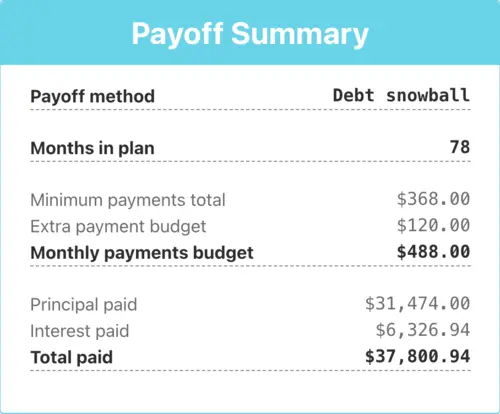
Payment Plan
This section breaks down your payment strategy into steps, each detailing a specific action to take. Each step is indicated by a step number and represents the specific monthly payment you will make to each account for the period of time specified for the step. Each step has the following information:
- Step #: This indicates the start of a new step. The steps are numbered in sequence and should be completed in the order indicated.
- Duration: Next to each step number is an instruction about how many months you will be repeating these payments. For example, the instruction “Pay monthly for 15 months” means that you will make the payment amount indicated to each debt every month and you will repeat that monthly payment scenario for 15 months.
- Payment detail: Each account that requires a payment during a step will be shown with the following information
- Account name: The name of the account you provided in your list of accounts.
- Payment Type Tag: Next to the account name, you will see a tag that indicates what type of payment you will be making for that account as follows:
- Minimum: Indicates that the minimum required payment should be made for this account.
- Extra: Indicates that this is the highest priority account during this step according to the debt snowball method. All extra payment amounts available are being applied to this account.
- Payoff: Indicates that this is the final payment needed in order to have this debt completely paid off. Yes! This will be a time to celebrate!
- Amount: To the far right of the account name and the payment type tag is the monthly payment amount to make for the associated account during this step.
- Total: This is the total of all payments you will make within the step. You will see that this amount is the same for most steps. This is because the minimum payments from debts that are eliminated are rolled forward as extra payments in later steps. This is the effect of the debt snowball method in action.
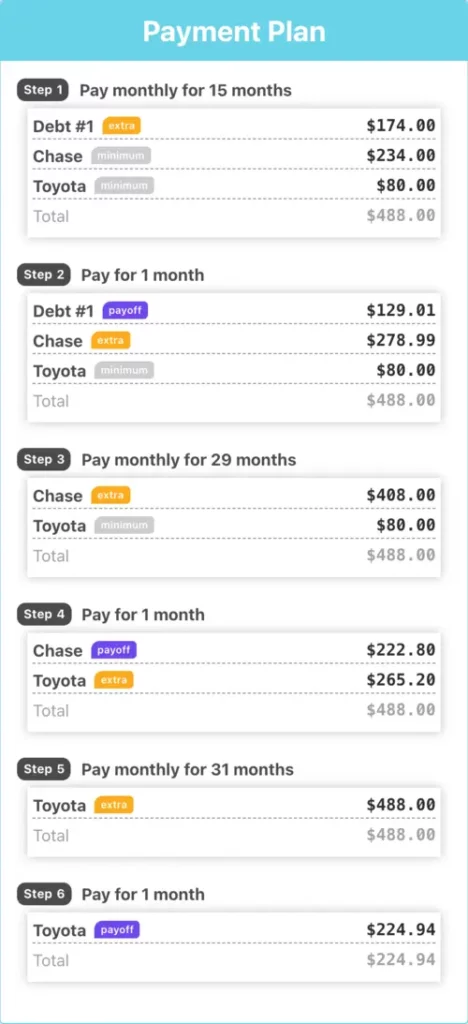
What's Great About the Debt Snowball Method
The Debt Snowball Method, popularized by financial expert Dave Ramsey, is a debt reduction strategy that has gained considerable acclaim for its psychological and motivational benefits. This method focuses on paying off debts in order of smallest to largest, regardless of interest rates. Here’s why it’s a great choice for many:
1. Psychological Boost
- Quick Wins: By targeting the smallest debts first, you experience the satisfaction of paying off individual debts more quickly. These quick wins provide a psychological boost and a sense of accomplishment.
- Motivation: As you see debts disappearing, your motivation to continue paying off larger debts increases. This momentum is a key factor in the success of the snowball method.
2. Simple and Straightforward
- Ease of Use: The Debt Snowball method is easy to understand and implement. You don’t need to be a financial expert to follow it, making it accessible to a wide range of people.
- Clear Path: With a straightforward approach, you always know which debt is your next target, reducing the stress and confusion that can come with debt repayment.
3. Behavioral Approach
- Habit Building: This method helps in building disciplined financial habits. As you allocate extra payments towards the smallest debts, you gradually develop a habit of making regular payments.
- Emotional Consideration: The method takes into account the emotional aspect of dealing with debt, acknowledging that seeing debts cleared can be more motivating than the mathematical aspect of interest rates.
4. Adaptability
- Flexibility: While the method has a set rule for the order of debt repayment, it’s flexible in terms of the amount you pay. This adaptability makes it suitable for a variety of financial situations.
While the Debt Snowball method offers these significant advantages, it’s important to recognize that it’s not a one-size-fits-all solution. Depending on your personal financial situation, goals, and motivation, other debt repayment methods might align better with your needs. In the following section, we explore several alternative methods, each with its unique approach to prioritizing debt payments. Whether you’re looking for a method driven by financial efficiency, emotional factors, or a specific financial goal like improving your credit score, there’s a strategy that can suit your journey towards financial freedom.
Other Methods To Consider
Having explored the Debt Snowball method’s unique advantages, such as its psychological benefits and straightforward approach, it’s important to remember that personal finance is just that—personal. What works wonderfully for one individual may not be the best fit for another. Your financial situation, goals, and personal preferences play a crucial role in determining the most effective strategy for you.
In this section, we delve into a variety of alternative debt repayment methods. Each of these strategies offers a different perspective on how to tackle your debts, whether you’re motivated by saving on interest, improving your credit score, or channeling your emotions into a productive payoff plan. By understanding these diverse approaches, you can make an informed decision that aligns with your financial situation and goals.
Here’s a comprehensive comparison of these methods, highlighting their debt prioritization criteria, underlying motivation, and the specific circumstances for which they are best suited:
| Method | Debt Prioritization | Why Choose This Method |
|---|---|---|
| Debt Snowball | Smallest balance debts first | Provides quick wins, boosting morale and motivation to tackle larger debts. |
| Debt Avalanche | Highest interest rate debts first | Saves money by reducing total interest paid, efficient for long-term debt reduction. |
| Credit Score Focus | Newest debts first | Improves credit score faster, as newer debts have a greater impact on credit ratings. |
| Anger Method | Most frustrating debts first | Uses negative emotions as motivation to eliminate frustrating debts. |
| Cash Flow | Highest minimum payment debts first | Frees up cash flow sooner, allowing for more flexibility in budget and further debt payments. |
| Interest Rate Sensitivity | Highest likelihood of interest rate change debts first | Targets debts likely to become more expensive, avoiding risk of higher payments in a fluctuating interest rate environment. |
| Loan Term Method | Shortest remaining loan term debts first | Simplifies debt management by reducing the number of debts, focusing on short-term loans first. |
| Credit Utilization Method | Highest credit utilization ratio debts first | Lowers credit utilization to improve credit scores, beneficial for credit health and future borrowing. |
As you consider these alternatives, reflect on what you value most in a debt repayment plan. Whether it’s the simplicity and psychological wins of the Debt Snowball method or the financial efficiency of the Debt Avalanche, the right method for you is one that resonates with your financial habits, emotional needs, and long-term goals.
What to do Next
Step 1: Explore the Debt Snowball Calculator
Begin your journey toward financial freedom by using the debt snowball calculator on this page. This intuitive tool allows you to input your specific debt information and see a personalized projection of how the Debt Snowball method can work for you. It offers a clear visualization of your potential debt-free timeline and a breakdown of payments over time. This step is crucial for understanding the method’s impact on your individual financial situation.
Step 2: Dive into the Debt Payoff Planner App
After getting a sense of what the Debt Snowball method can do for you by using the debt snowball calculator, it’s time to unlock the full potential of your debt-free journey with the Debt Payoff Planner app. This comprehensive app offers an array of features that go beyond basic calculations, providing you with everything you need to achieve less stress, more motivation, and a faster payoff.
- Versatile Debt Payoff Strategies: Whether it’s the Debt Snowball, Avalanche, or any other method, the app supports various strategies, allowing you to compare and choose the best fit for your financial goals.
- Complex debt support: The app caters to a range of complex financial situations, including varying payment frequencies, promotional rates, and scenarios involving one-time extra payments such as tax returns or bonuses.
- Optimization Tools: Make the most of your financial resources with tools designed to optimize your debt payoff strategy, ensuring efficient and effective use of your payments.
- Progress Tracking: Visual trackers and detailed progress reports keep you motivated by showing you exactly how each payment is bringing you closer to your goal of being debt-free.
- Detailed Plan Breakdown and Visualization: Get a comprehensive view of your debt repayment journey with detailed breakdowns and visualizations of your payment plan. This feature helps you understand the nuances of your plan and stay on top of your progress.
- Multiple Device Access: Manage your debt payoff plan on your terms, with the ability to access your account from multiple devices. Whether at home, work, or on the go, you have the flexibility to keep track of your plan wherever you are.
- Educational Resources: The app provides valuable information and resources to enhance your understanding of debt management and financial health.
The Debt Payoff Planner app is more than just a planning tool; it’s a comprehensive solution that adapts to your unique financial circumstances, equipping you with everything you need to navigate your debt payoff journey effectively. Start with the calculator for an initial overview, and then take full control of your financial future with the app’s extensive features and capabilities. Embrace these tools as your allies on the path to financial independence.
Our team is dedicated to providing up-to-date financial information to help people manage their debt. Our goal is to improve mindset, reduce guilt, and deliver actionable information. We are not financial professionals and the information we’ve provided should not be considered official advice.
Warning!!!
payoffplanners.com is not affiliated with this site
It appears you have been directed to our site from a company falsely claiming to be affiliated with our product or service. Please be advised that we have no affiliation with payoffplanners.com.
Debt Payoff Planner is owned and operated by Oxbowsoft LLC, Oregon. If you have any questions please contact support@debtpayoffplanner.com
WARNING
payoffplanners.com is not affiliated with this site
It appears you have been directed to our site from a company claiming to be affiliated with our product or service. Please be advised the we have no affiliation with payoffplanners.com.
Debt Payoff Planner is owned and operated by Oxbowsoft LLC, Oregon. If you have any questions please contact support@debtpayoffplanner.com
